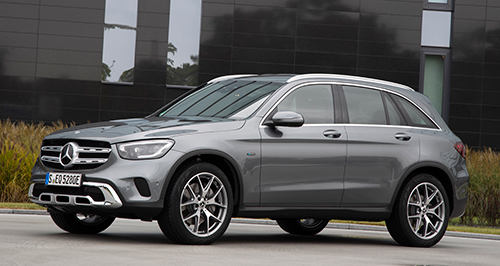Make / Model Search
Future models - Mercedes-Benz - GLCFrankfurt show: Mercedes confirms GLC PHEV for OzPlug-in hybrid drivetrain to fly efficiency flag as diesel drops from Benz GLC range12 Sep 2019 MERCEDES-BENZ continued its electrification rollout at this week’s Frankfurt motor show with plug-in hybrid versions of its latest-generation GLE large SUV and facelifted GLC mid-size SUV, the latter being confirmed to launch in Australia during the second quarter of next year.
The bigger diesel-electric GLE350de is not destined for this market, although GoAuto understands a petrol-electric version is in the works and will eventually reach these shores.
As reported, the facelifted GLC range that is due to launch in Australia within weeks will lack diesel variants. This leaves a gap for efficiency-focused buyers that could be plugged by the GLC300e that is expected to be priced in the region of $77,000-$80,000 plus on-road costs.
Like the C300e sedan that went on sale in Australia this month priced at $79,200 plus on-road costs, the GLC300e combines a 155kW/350Nm 2.0-litre turbo-petrol four-cylinder engine with 90kW/440Nm electric motor and 13.5kWh lithium-ion for a combined output of 235kW and 700Nm.
Adding all-wheel drive plus the height and weight of an SUV body cuts electric-only range of the GLC300e to between 39 and 43km under the Worldwide harmonized Light-duty vehicles Test Procedure (WLTP) depending on options fitted, compared with the sedan’s 52km, while fuel consumption of 2.2-2.5 litres per 100km is a touch higher than the C300e’s 2.1L/100km.
Similarly, 0-100km/h acceleration is 5.7 seconds versus 5.4s in the sedan. Boot capacity is reduced by 105 litres over the non-hybrid GLC, leaving 395L with the seats up, although the sedan’s 300L boot loses a substantial 155L compared with its combustion-only counterpart.
A full recharge using the Type 2 connector takes five hours using a domestic power outlet or 1.5 hours using an optional wallbox charger.
The beefier GLE350de has a much larger 31.2kWh lithium-ion battery that provides between 90 and 99km of range (WLTP) from the 100kW/440Nm electric motor, while the combustion component is a 2.0-litre turbo-diesel producing 143kW and 400Nm.
Combined fuel consumption is rated at just 1.1L/100km, regenerative braking works on all four wheels and it takes 6.8 seconds for the diesel-electric GLE to hit 100km/h from rest. Also, the GLE350de can tow up to 3500kg braked.
The bigger battery necessitates DC fast-charging capacity, which enables a charge from 10 to 80 per cent to be completed in 20 minutes, or 100 per cent in 30 minutes.
Both SUVs send drive to all four wheels through a nine-speed automatic transmission.
On both models, the high-voltage battery powers the air-conditioning, heater and vacuum pump for the braking system. In addition to running these systems when the combustion engine is not operating, cabin temperatures can be pre-set remotely.
Aside from comfort benefits, if the driver’s desired cabin temperature is reached while the car is plugged in, more battery energy is available for driving the wheels and electric-only range is increased.
Traffic and terrain data gathered from the satellite navigation, radar and cameras are also used to help optimise energy usage as well as how much is recovered from regenerative braking.  Read more9th of August 2019  Mercedes GLE to increase sales in new generationBenz banks on fresh GLE outperforming predecessor but cautious about toppling X513th of June 2019  First drive: Mercedes GLC diesel future uncertainUpdated Mercedes-Benz GLC mid-size SUV arriving with petrol-only powerAll future models Alfa Romeo Alfa Romeo Abarth Abarth Alpine Alpine Alpina Alpina Audi Audi Aston Martin Aston Martin BMW BMW Bentley Bentley Chery Chery Brabham Brabham Chrysler Chrysler Chevrolet Chevrolet Cupra Cupra Citroen Citroen DS DS Dodge Dodge Fiat Fiat Ferrari Ferrari Foton Foton Ford Ford Great Wall Great Wall FPV FPV Haval Haval GWM GWM Honda Honda Holden Holden Hummer Hummer HSV HSV Infiniti Infiniti Hyundai Hyundai Jaguar Jaguar Isuzu Isuzu Kia Kia Jeep Jeep Land Rover Land Rover Lamborghini Lamborghini Lexus Lexus LDV LDV Mahindra Mahindra Lotus Lotus Mazda Mazda Maserati Maserati Mercedes-AMG Mercedes-AMG McLaren McLaren MG MG Mercedes-Benz Mercedes-Benz Mitsubishi Mitsubishi Mini Mini Opel Opel Nissan Nissan Peugeot Peugeot Pagani Pagani Proton Proton Porsche Porsche Renault Renault Ram Ram Rover Rover Rolls-Royce Rolls-Royce Skoda Skoda Saab Saab SsangYong SsangYong Smart Smart Suzuki Suzuki Subaru Subaru Toyota Toyota Tesla Tesla Volvo VolvoGLC pricing
Motor industry news |
Click to shareMercedes-Benz modelsResearch Mercedes-Benz All future models Alfa Romeo Alfa Romeo Abarth Abarth Alpine Alpine Alpina Alpina Audi Audi Aston Martin Aston Martin BMW BMW Bentley Bentley Chery Chery Brabham Brabham Chrysler Chrysler Chevrolet Chevrolet Cupra Cupra Citroen Citroen DS DS Dodge Dodge Fiat Fiat Ferrari Ferrari Foton Foton Ford Ford Great Wall Great Wall FPV FPV Haval Haval GWM GWM Honda Honda Holden Holden Hummer Hummer HSV HSV Infiniti Infiniti Hyundai Hyundai Jaguar Jaguar Isuzu Isuzu Kia Kia Jeep Jeep Land Rover Land Rover Lamborghini Lamborghini Lexus Lexus LDV LDV Mahindra Mahindra Lotus Lotus Mazda Mazda Maserati Maserati Mercedes-AMG Mercedes-AMG McLaren McLaren MG MG Mercedes-Benz Mercedes-Benz Mitsubishi Mitsubishi Mini Mini Opel Opel Nissan Nissan Peugeot Peugeot Pagani Pagani Proton Proton Porsche Porsche Renault Renault Ram Ram Rover Rover Rolls-Royce Rolls-Royce Skoda Skoda Saab Saab SsangYong SsangYong Smart Smart Suzuki Suzuki Subaru Subaru Toyota Toyota Tesla Tesla Volvo VolvoGLC pricing
Motor industry news |











Facebook Twitter Instagram